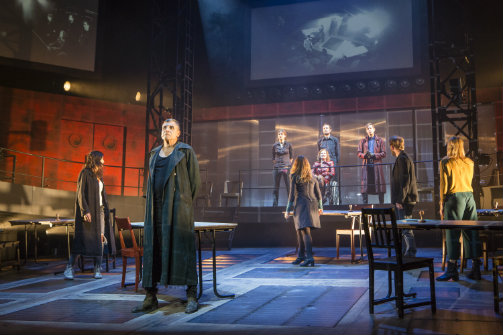State of Siege (L’État de siège)
By Albert Camus; Directed by Emmanuel Demarcy-Mota
Produced by Théâtre de la Ville
Part of BAM's 2017 Next Wave Festival
Off Broadway, Play Revival
Runs through 11.4.17
BAM Howard Gilman Opera House, 30 Lafayette Avenue
by Dan Dinero on 11.4.17
 The company of State of Siege. Photo by Ed Lefkowicz.
The company of State of Siege. Photo by Ed Lefkowicz.
BOTTOM LINE: This stylized production of this lesser-known play by Camus makes the allegory to our present state abundantly clear.
“Everything vanishes in the face of fear,” a line from Camus’ State of Siege, is a familiar sentiment to those looking to explain how a deceitful, racist, and misogynist reality show host became President. And while, unlike the Public Theater’s much-misunderstood recent staging of Julius Caesar, Théâtre de la Ville’s production doesn’t make any explicit links to our situation in the U.S., there is plenty of material here that will resonate with American audiences.
It’s summer in Cadiz, Spain. Everyone is happy. But then a comet is spotted, and it’s clear that the happy times are over. Soon the Plague (Serge Maggiani) appears, accompanied by his secretary (the fabulously-clad Valérie Dashwood), who can kill people by ripping a page out of her ledger (she’s Death, of course). The two seize control of the town, quickly turning it into a fear-based dictatorship, until one man stands up for what is right. That is Diego (Matthieu Dessertine), the love of Victoria (Hannah Levin Seiderman). Because he isn’t afraid, Death allows him to live, enabling him to beat back the Plague and save his town, although not without cost.
The Plague here functions as both disease and dictator—he is both biological and philosophical in nature, and to reduce him to one or the other is to miss the ways that perceived environmental threats feed into, and are exacerbated by, dangers of the political kind. Director Emmanuel Demarcy-Mota clearly perceives this duality, and doesn’t shy away from physical manifestations of the Plague’s wrath. For example, Fanny Brouste’s simple yet effective costumes are staunchly contemporary, yet the townspeople who handle the dead bodies wear a version of the beak-nosed “plague doctor” masks used four hundred years ago.
Yet for many, the hauntingly familiar behavior of the increasingly dictatorial state will be what stands out. Rights are abridged, goodness and justice are demonized, and people are killed at random—as one of the characters says, “If crime becomes law, it is no longer crime.” If such critiques of the ways that dictatorships seize and hold power may seem familiar to anyone who’s read 1984 or seen Ionesco’s Rhinoceros (perhaps even Théâtre de la Ville’s version, which played at BAM in 2012), that doesn’t make it any less relevant.
In one scene, the townspeople are forced to secure “Certificates of Existence,” since “the whole point of our government is that you always need a certificate.” Given the increased push for arresting and deporting those without paperwork, and the rise in problematic laws around so-called Voter IDs, this reminder of the tyranny of bureaucracy, and the ways in which documentation and the lack of privacy (hello, social media) all feed into sinister governmental surveillance, is especially timely.
Aesthetically, this State of Siege has many of the hallmarks of other large-scale European productions that play BAM’s Next Wave Festival. It’s polished and slickly contemporary with lots of metal and clear plastic, multiple video screens (in this case, they don’t seem to add much), tons of mood lighting, and significant attention to creating striking stage pictures. Such design can veer from the sublime to the indulgent, but for those who take intense pleasure in the occasional moment of theatrical bliss, Demarcy-Mota manages a few here, as at the end of the first part, when an enormous black tarp is slowly pulled off the stage.
Ultimately, to dismiss State of Siege as mere allegory is to miss the point. Sure, this isn’t a play with richly drawn characters, or a “well-made” plot. And yes, the gender politics are, to our 21st-century eyes, a bit dated: while Diego is the active protagonist, his girlfriend Victoria has little to do besides feel things (love, fear, sadness) that all revolve around him. But to my mind, there is always room for allegory on our stages, especially in such times of crisis. If State of Siege doesn’t directly help us wrest power back from 45 and his minions, at the very least it might help us understand the machinations behind the scenes. And there has to be value in that.
(State of Siege plays at BAM's Howard Gilman Opera House, 30 Lafayette Avenue, through November 4, 2017. The running time is 2 hours with no intermission. Performances are Thursday through Saturday at 7:30. Tickets are $25 - $85. For more information visit bam.org.)
State of Siege is by Albert Camus. Directed by Emmanuel Demarcy-Mota. Assistant Director is Christophe Lemaire. Set Design by Yves Collet. Lighting Design by Yves Collet and Christophe Lemaire. Costume Design by Fanny Brouste. Sound Design by David Lesser. Image Design by Mike Guermyet. Mask Design by Anne Leray. Make-up Design by Catherine Nicolas. American Stage Manager is R. Michael Bianco. Produced by Théâtre de la Ville.
The cast is Jauris Casanova, Valérie Dashwood, Alice Demarcy, Philippe Demarle, Matthieu Dessertine, Sandra Faure, Sarah Karbasnikoff, Alain Libolt, Serge Maggiani, Gérald Maillet, Hugues Quester, Walter N’Guyen, Hannah Levin Seiderman, and Pascal Vuillemot.

